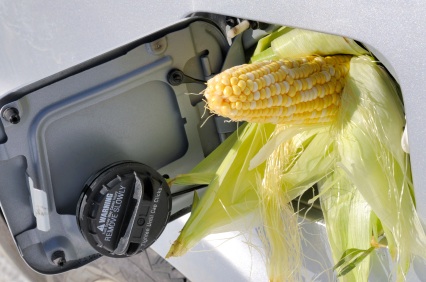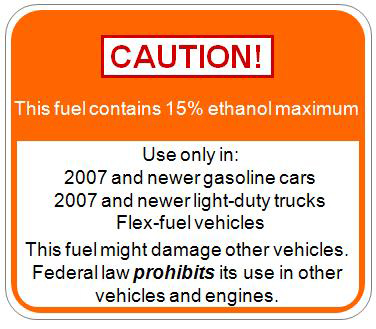 Is that a corn cob in your gas tank, or are you just happy about the EPA’s ruling?
Is that a corn cob in your gas tank, or are you just happy about the EPA’s ruling?
Updated 4:45pm
It seems like years ago that USDA Secretary Tom Vilsack stood on the steps of the Environmental Protection Agency headquarters and shouted, “Mr. President, tear down that blend wall!“* What he wanted, of course, was to raise the current limit on the amount of ethanol that can be mixed into gasoline, now restricted to 10 percent by volume.
The ethanol lobby then petitioned the EPA to allow the sale of gasoline with 15 percent ethanol (known by the snappy acronym E15), which would instantly create a larger market for the additive. From there, much regulatory hilarity ensued as a result of the fact that gasoline blends containing more than 10 percent ethanol can corrode many kinds of engines and void consumer warranties. A point not lost on auto, boat, and small engine manufacturers. Oops!
But no matter. Almost a year late but three weeks away from a midterm election in which Democrats are about to be bodyslammed by an electorate infuriated by 10 percent unemployment, the EPA has acted to shore up the candidacies of threatened Midwestern Congresscritters and Governors/the finances of ethanol companies/corn prices by approving the new formulation. E15 for all!
Well, not exactly. Despite the fears of some, like blogger Kevin Drum, the EPA’s ruling will not have us “drowning in ethanol” quite yet. The EPA only approved the sale of E15 for cars and light trucks made in 2007 or later. This is somewhat surprising given that preliminary tests showed it was safe for vehicles made after 2001. I guess the EPA thought that instantaneously invalidating 100 million warranties wasn’t such a hot idea. And significantly, the agency explicitly rejected the idea of using E15 in cars made before 2000.
To provide pumps for cars made in different years, the gasoline industry would have to roll out a whole new parallel gas pump infrastructure. Aside from the obvious cost hurdles, The New York Times points out that gas stations don’t have the ability to store another gas formulation. Moreover, E15 would damage the hoses of gas pumps. Even if you could overcome all of that, you’d still have to find someone to make the stuff and gas stations willing to sell it. Back in December, Phil Brasher of the Des Moines Register provided evidence that refiners had zero interest in producing E15 — at least without an act of Congress protecting them from liability over those consumer warranties.
And I just received a similar reaction from Valero, one of the nation’s largest petroleum refiners, as well as a retailer and an ethanol producer. A spokesmen told me that they have no plans to produce E15 at the moment, observing that “it’s hard to imagine any retailer, including Valero, selling the E-15 blend at its sites without liability or warranty protection.” The fact is, no refiner is going to want to make E15 and few retailers will carry it. Who needs the trouble! Separate pumps, consumer confusion, warranty complications. Oh my!
Even ethanol lobby powerhouse Growth Energy could only muster the tepid endorsement that the EPA’s decision was a “crack in the blend wall.” It’s true that after the election, the EPA will decide if E15 is safe for cars made after 2001, but yes or no, it won’t change the fact that E15 is the ugly duckling of fuel products.
Indeed, as political panders go, I give this one a thumbs up. It’s likely to have no effect — and maybe it will save some endangered Democrats. The whole E15 mishegas is really just a distraction. With corn prices now pushing $6 a bushel and rising — caused in part by lower than expected yields — the food vs. fuel fight rages anew. And that’s a funny thing — we’ve been promised that the ever-increasing productivity of American corn producers would prevent this kind of thing from happening. Apparently not.
If you are of a suspicious bent, ignore the EPA, which does not seem to be much of an ethanol fan (after all, the agency infuriated the industry and its Congressional backers when it flirted with the idea of factoring ethanol’s “indirect land use” on the additive’s climate impact). The White House is the place to watch: according to ag reporter Chris Clayton, President Obama’s new (and perhaps temporary) chief of staff, Pete Rouse, was at one time chief of staff to Senator and ethanol supporter Tom Daschle (D-SD) and was very involved in ethanol issues.
To go all Rubicon on you, while in Daschle’s employ Rouse worked alongside none other than Tom Buis, who is now head of Growth Energy, the largest ethanol lobbying group. And while Obama himself has of late spoken less about ethanol in his energy speeches, here’s hoping Rouse and Buis don’t tag-team to get ethanol back to the top of President Obama’s energy priorities — or make a strong push to extend the expiring ethanol tax credit. I find this prospect of far greater concern than the EPA’s approval of gasoline blends that will never see the light of day.
It will come as a surprise to no one to learn that ethanol is not really an energy policy. It’s unquestionably a lousy power source. In fact, scientists just determined that simply burning a feedstock to create electricity is more efficient from an energy and climate perspective than turning that feedstock into ethanol. In other words, ethanol is a waste of time, money and energy.
But then, ethanol is nothing less than Congress’s answer to agricultural subsidy reform — and in a narrow sense, it has been a tremendous success. Corn prices are high and rising, which is good for commodity corn farmers — many of whom aren’t so much drowning in ethanol as they are kept afloat by it. Of course, ethanol has allowed us to kick the agricultural subsidy reform can down the road several decades and with several powerhouse lobbies behind it, seems here to stay.
This is a missed opportunity on many levels. While we’re stuck on corn ethanol, other countries have been been doing the pioneering research into future fuels. A group of Swedish researchers just claimed the discovery of an enzyme (perhaps the enzyme we’ve all been waiting for) that may open the door to cellulosic ethanol, which can be made from non-food feedstocks like wood waste and crop residue. Once again, while we s
ubsidize the status quo, the alternative energy action is elsewhere.
*Not literally.
UPDATE: Still not convinced the EPA is no friend to ethanol? Check out the agency’s proposed label for E15 gasoline. Ethanolistas are not amused.

Image courtesy EPA




